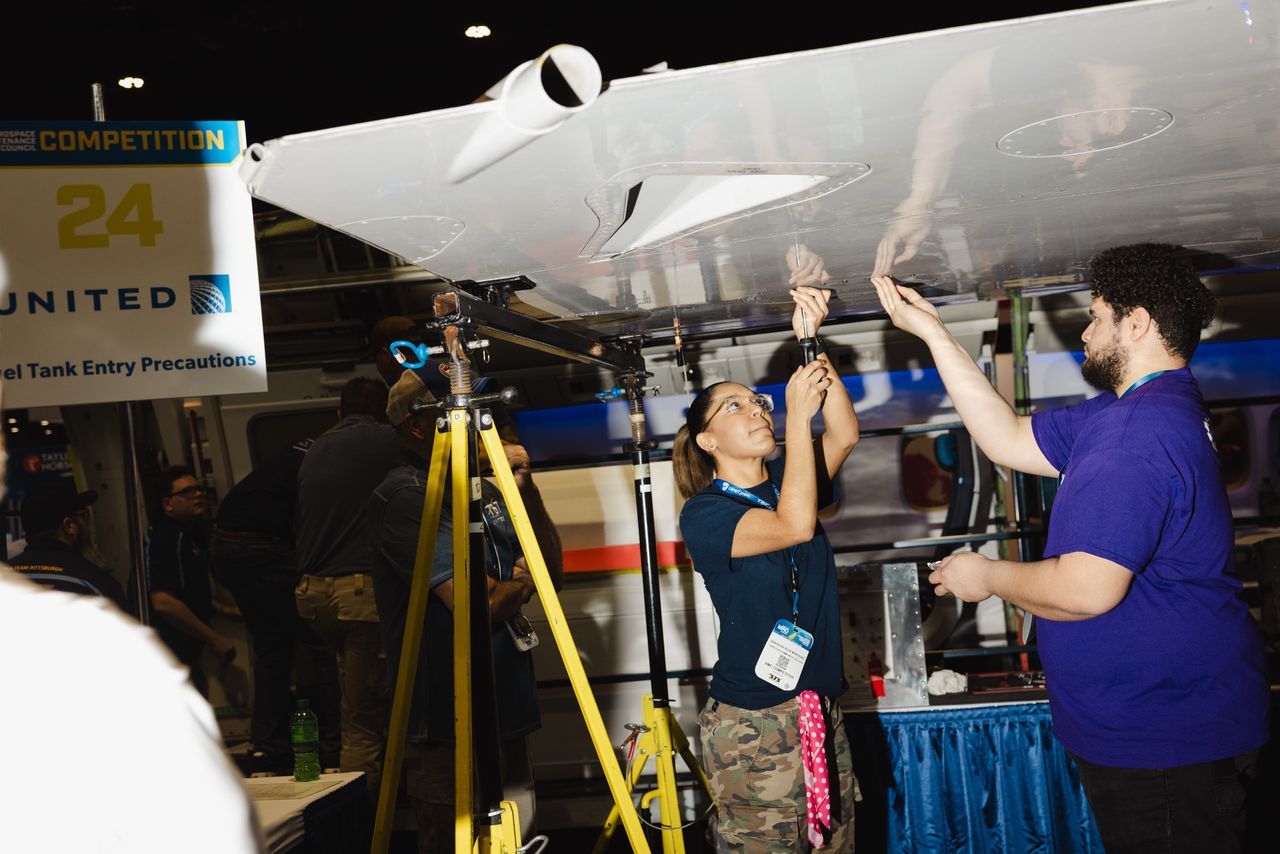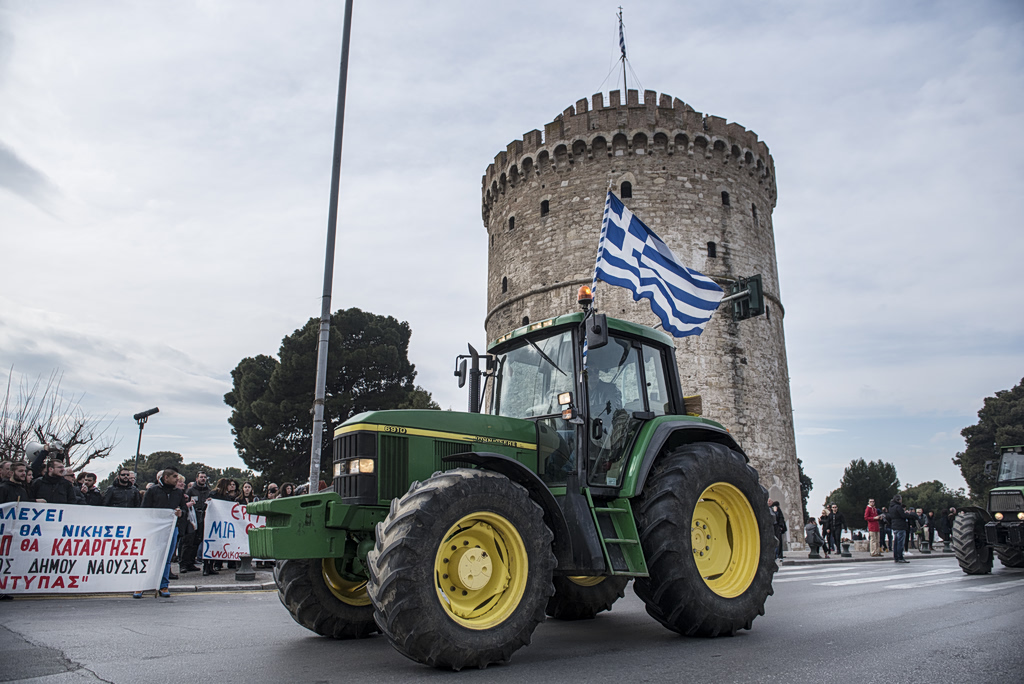CHICAGO—A bird flies into an airplane engine after touchdown. Mechanics are faced with the task of removing and replacing a fan blade. There are six minutes on the clock. The pressure is on.
The two mechanics aren’t in an airport hangar, though. They are in McCormick Place Convention Center, in the annual Aerospace Maintenance Competition.
A crowd formed Tuesday, on edge as the mechanics methodically tapped each blade back into position, rotating them counterclockwise and trying to keep them from locking up. Spectators erupted in cheers when the two American Airlines workers clicked the final blade in.
“I’m shaking a little bit—I was really nervous for this event,” said Mike O’Connell, clad in his team’s bright blue jersey. “We came in here just wanting to finish the event. We didn’t just finish it, we killed it.”
More than 450 airplane mechanics from airlines, the military, other aviation companies and school programs around the world descended on Chicago last week to show off their skills and vie for bragging rights at the annual Olympics of airplane maintenance. Companies or other groups can field multiple five-person teams, and each team competes in all of the 27 events.
Two-time reigning champs from FedEx Express were looking for a three-peat, but Team Herb, a Southwest Airlines team named for the airline’s co-founder, emerged victorious with the overall award, taking home a 4-foot trophy with the bust of the mechanic who worked with the Wright Brothers.
Train like athletes
The event took place during a larger aviation maintenance, repair and overhaul conference and trade show. An announcer called the start of each event: “Ready, set, start!”
In 15-minute slots, members of each team raced to complete sped up, concentrated versions of tasks they do at work: troubleshoot malfunctioning switches, secure wires, inspect tires, fix a broken light and empty and refill a fuel tank.
United Airlines brought a hunk of a fuselage from a retired Boeing 767 that employees drove from Tupelo, Miss. Three mechanics from each team had to follow the procedure to remove and reinstall an emergency slide pack—a crucial skill. Slides that improperly deploy can cause injuries and thousands of dollars worth of damage.
Preparations began weeks ago. Kayler and Evan Randall, brothers who work at Horizon Air, a regional airline owned by Alaska Air, said their team flew up to Anchorage for a few days of training alongside the Alaska crew and a team of students they mentored. American devoted a room to competition prep at its Tulsa maintenance facility.
Brian Davidson of FedEx compared the adrenaline rush to triathlons he has raced. His team often taps athletes in their ranks to gain an edge, he said.
“You put so much work in—six weeks of training, then today’s the day. You’ve got to perform.”
Southwest made a push for a win this year. Its mechanics holed up in a conference room for about a month, building mock-ups and studying instructions to plan their attack, said Matthew Chumley, who was on a second Southwest team.
Worried they would be at a disadvantage for the slide event since Southwest doesn’t have any 767 jets, the Southwest technicians tapped a connection at another carrier to scope out the plane.
“Every year we’ve gotten better,” he said.
After a door plug blew out from a Boeing plane flown by Alaska Airlines in January, jittery fliers have been more focused on airplane safety. Regulators are more closely scrutinizing Boeing ’s manufacturing processes and have said they’re stepping up oversight at United Airlines after a number of incidents.
With all the extra scrutiny , some mechanics say they’re happy for the chance to show what they can do.
“Our profession has earned the right to stand forward and just be acknowledged for their knowledge, skill and integrity,” said Ken MacTiernan, an American Airlines mechanic and one of the competition’s founders. “We’re the guardians of safety. And we don’t take our responsibilities lightly.”
Airlines sorely in need of more maintenance technicians use the contest as a recruiting opportunity. Carriers sponsor student teams and provide coaching, in many cases hiring from their ranks.
For airplane maintenance technicians, the competition is a rare moment in the spotlight. Most work behind the scenes, often overnight when planes can take a break from flying paying passengers.
“I always tell even our executives—we don’t break them, we fix them! Thank that technician you see onboard,” said Don Wright, vice president of maintenance and engineering at Alaska.
‘Walk of shame’
Mechanics are accustomed to high stakes and working under time constraints, like when there’s a plane full of passengers waiting for a repair. They are also acutely aware nobody is happy to see someone in a bright orange vest approaching a plane right before departure—they dread the “walk of shame” through the cabin when they have to fix something at the back of the plane, with dozens of irritated passengers staring them down.
In real life, mechanics say precision is paramount, even if it means there’s a delay. In competition, however, speed is also crucial. A winning score is based both on having the quickest time and avoiding penalties for mistakes, from not following instructions to improperly storing tools.
“We never do this in real life—we’re never rushing at work,” said Yolanda Gong, who competed as a student and is now on United’s all-female Chix Fix team. “Everything here is about procedure and did you follow it? It’s great to shine a light on that.”
The competition is good-natured, but rivalries form. Contestants say they suspect airlines design events that might stump rivals. To keep things fair, a team can’t win an event its airline sponsored. But United teams breezed through their airline’s slide event, while others struggled to finish it.
United mechanics are quick to point out they had similar struggles last year when FedEx debuted its cargo floor lock event, using equipment they weren’t used to.
Sorin Bucur, captain of Spirit Airlines ’s team and a senior manager of maintenance for the airline at O’Hare, said smaller carriers don’t have the same access to equipment for practice. “We’re out here doing our best.”
Szymon Lysek and Raul Cancino, students at Aviation Institute of Maintenance in Chicago, thought they were done for when they inadvertently pulled out three blades from the engine during the fan blade event. They were sure they wouldn’t be able to shimmy them back into place in time.
“We kept just talking to each other,” Lysek said. “We just knew that the time wasn’t up yet. So we didn’t give up,” he said. “We’re students and we were able to get it in—that’s an accomplishment.”
Later, on the other side of the showroom floor, Spirit mechanics Nathaniel Preusse and Michael Marchut worked in tandem, following the steps they would take to empty a fuel tank and transfer the fuel, examine the tank for debris, then refill it.
“You guys got this, take your time!” a Spirit leader called out from the sidelines. Marchut’s fiancée was in the crowd. There was a brief moment of confusion after a team competing nearby on the same event accidentally took the Spirit team’s bolts before they could use them to reattach the panel. Bolts recovered, each made a satisfying popping noise as it was torqued.
Doing the job with an audience that can include friends and family, not to mention senior executives hovering nearby, can up the intensity. The first time she competed, Elena Gonzalez, of American Airlines, said her hands shook and her mind went blank.
“I could not hold the tool straight and feed the cable through the hole. It was just so much pressure,” she said. “You have to put yourself in the moment and you have to focus on exactly what it is that you’re doing.”
Her favorite event is also one of the most feared: a series of safety wiring challenges nicknamed the “blood box” because contestants tend to poke and slice themselves as they wind the steel wires. Judges keep Band-Aids and a can of Lysol nearby for wipedowns.
Gonzalez’s technique is to keep her hands off the wires as much as possible. “I’m all pliers.”
Write to Alison Sider at alison.sider@wsj.com



